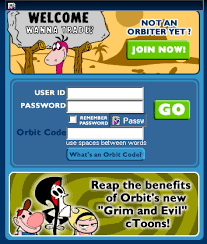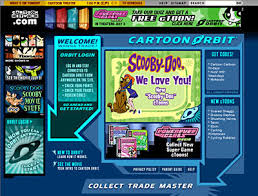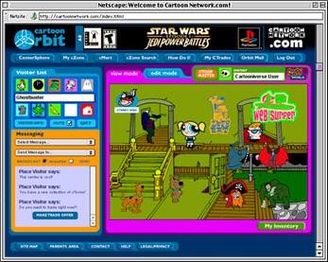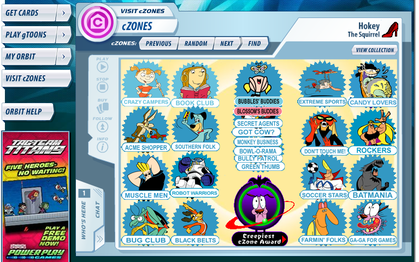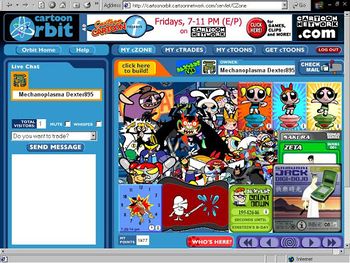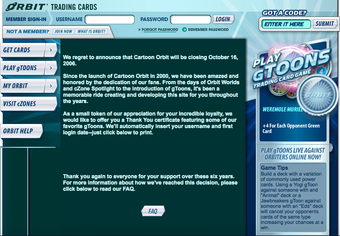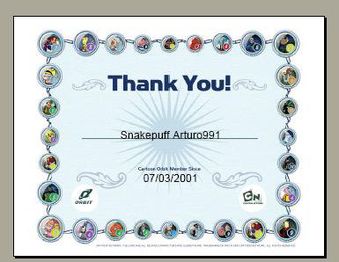Cartoon Orbit (partially found defunct online game; 2000-2006): Difference between revisions
(→Features: +more?) |
(+more and less) |
||
| Line 10: | Line 10: | ||
Launched on September 27, 2000, ''Cartoon Orbit'''s main focus was an electronic trading card system for players to buy, sell, and trade "cToons", which were sticker-like stills or animated GIFs from different Cartoon Network and Hanna-Barbera properties. Typical cToon artwork featured one or more characters (sometimes posing) or a recognizable object from the series, but not all cToons met this criteria. Players could initially obtain cToons by buying, selling, and trading, but as the game developed further, new methods were added that increased cToon availability. | Launched on September 27, 2000, ''Cartoon Orbit'''s main focus was an electronic trading card system for players to buy, sell, and trade "cToons", which were sticker-like stills or animated GIFs from different Cartoon Network and Hanna-Barbera properties. Typical cToon artwork featured one or more characters (sometimes posing) or a recognizable object from the series, but not all cToons met this criteria. Players could initially obtain cToons by buying, selling, and trading, but as the game developed further, new methods were added that increased cToon availability. | ||
New users were given a set of starter cToons and an amount of points to use for buying more cToons at the game's "cMart". The cMart acted as both a place to purchase cToons and a gallery of all cToons necessary to complete a set. Statistics and further information for individual cToons were obtainable from the cMart, including the number released, the date released, the set a cToon belonged to | New users were given a set of starter cToons and an amount of points to use for buying more cToons at the game's "cMart". The cMart acted as both a place to purchase cToons and a gallery of all cToons necessary to complete a set. Statistics and further information for individual cToons were obtainable from the cMart, including the number released, the date released, the set a cToon belonged to, the number available, and a short description of the character or artwork. The cMart contained valuable availability statuses for every cToon, which declared whether a cToon was available for purchase, sold out, or promotional only. Special checklist cToons were made to be printed off so that users could keep track of their collections. | ||
Every player on ''Cartoon Orbit'' was given the space to lay out their collected cToons in front of a "cZone", an online space containing a background image from a cartoon. Player background images were determined by which "World" the player chose during initial sign-up , but this could be changed by the player later on. Players were given the opportunity to put any cToon, including duplicates, on their cZone in any fashion. ''Orbit'''s cZones did not host any image-modifying features, so users were only able to display the cToons they owned with the original artwork intended. A cZone spotlight showcase featured a gallery of user cZones that were popular at the time. | Every player on ''Cartoon Orbit'' was given the space to lay out their collected cToons in front of a "cZone", an online space containing a background image from a cartoon. Player background images were determined by which "World" the player chose during initial sign-up , but this could be changed by the player later on. Players were given the opportunity to put any cToon, including duplicates, on their cZone in any fashion. ''Orbit'''s cZones did not host any image-modifying features, so users were only able to display the cToons they owned with the original artwork intended. A cZone spotlight showcase featured a gallery of user cZones that were popular at the time. | ||
===Features=== | ===Features=== | ||
| Line 22: | Line 19: | ||
To initiate a trade between accounts, two or more users visiting the same cZone at the same time could select a predetermined chat message with a link to a page for trading. Both account users needed to accept a trade before it went through, but glitches discovered later on allowed dishonest users to manipulate the trading results. Introduced after the original game went online was the auctions page, which allowed users to sell their cToons individually to the highest-bidding user. | To initiate a trade between accounts, two or more users visiting the same cZone at the same time could select a predetermined chat message with a link to a page for trading. Both account users needed to accept a trade before it went through, but glitches discovered later on allowed dishonest users to manipulate the trading results. Introduced after the original game went online was the auctions page, which allowed users to sell their cToons individually to the highest-bidding user. | ||
Special cToons were released to commemorate holidays, awards shows, elections, zodiac signs, and film releases such as ''The Powerpuff Girls Movie''. Occasionally these released as "cRings", which featured artwork in a template that displayed the cRing's name below. A set of movie posters containing parodies of older and contemporary films released, including "Bend It Like Bubbles", "Pirates of the Cul-De-Sac", and "Finding Mojo" (all featuring Cartoon Network characters). | Special cToons were released to commemorate holidays, awards shows, elections, zodiac signs, and film releases such as ''The Powerpuff Girls Movie''. Occasionally these released as "cRings", which featured artwork in a template that displayed the cRing's name below. A set of movie posters containing parodies of older and contemporary films released, including "Bend It Like Bubbles", "Pirates of the Cul-De-Sac", and "Finding Mojo" (all featuring Cartoon Network characters).<ref>[https://web.archive.org/web/20221011232236/https://news.theetcc.net/CNOCNewsArchive/news50.html 2004-02-25 "CNOC Newsletter #50"] Retrieved October 2022 | ||
Promotional "AdToons" cToons could be obtained by entering an "Orbit Code" found on merchandise including Nestle Ice Screamers, Pop-Tarts, and Little Golden Books. Other promotional codes could be discovered by playing Shockwave Flash games on CartoonNetwork.com. Though most of the games containing codes could be accessed by anyone visiting the site, a small number of games, such as Winball, were exclusive to ''Orbit'' users. Limited-time cToon codes were sometimes revealed during broadcasts of ''Cartoon Cartoon Fridays'', a programming block that ran from April 30, 1999, to February 23, 2007.<ref>[http://members.tripod.com/collector_cliff/cartoon_orbit_promos.html "cToon Code Information"] Retrieved Jun '20</ref><ref>[https://archive.org/details/cartoon-orbit-code-fossil-2002-02-08 "Orbit code broadcast example"] Retrieved May '21</ref> These "CCF" cToons often featured the likeness of the cartoon character hosting the block. | Promotional "AdToons" cToons could be obtained by entering an "Orbit Code" found on merchandise including Nestle Ice Screamers, Pop-Tarts, and Little Golden Books. Other promotional codes could be discovered by playing Shockwave Flash games on CartoonNetwork.com. Though most of the games containing codes could be accessed by anyone visiting the site, a small number of games, such as Winball, were exclusive to ''Orbit'' users. Limited-time cToon codes were sometimes revealed during broadcasts of ''Cartoon Cartoon Fridays'', a programming block that ran from April 30, 1999, to February 23, 2007.<ref>[http://members.tripod.com/collector_cliff/cartoon_orbit_promos.html "cToon Code Information"] Retrieved Jun '20</ref><ref>[https://archive.org/details/cartoon-orbit-code-fossil-2002-02-08 "Orbit code broadcast example"] Retrieved May '21</ref> These "CCF" cToons often featured the likeness of the cartoon character hosting the block. | ||
| Line 29: | Line 26: | ||
==Closure== | ==Closure== | ||
In early 2005, ''Cartoon Orbit'' began to become less and less under maintenance, causing it to suffer greatly in accessibility, and little to no updates were made. | In early 2005, ''Cartoon Orbit'' began to become less and less under maintenance, causing it to suffer greatly in accessibility, and little to no updates were made after February 2006. Registration for new accounts closed on August 17, 2006. | ||
''Cartoon Orbit'' was shutdown on October 16, 2006. The users were left with a certificate as a thank you for their support of the game | ''Cartoon Orbit'' was shutdown on October 16, 2006. The users were left with a certificate as a thank you for their support of the game. | ||
==Massive Cartoon Orbit Archival Project== | ==Massive Cartoon Orbit Archival Project== | ||
The Massive Cartoon Orbit Archival Project (MCOAP) is an Internet archival website run on Toonarific.com, a website run by a person who had connections with the ''Cartoon Orbit'' developers. Its entries include full cToons and gToons as well as | The Massive Cartoon Orbit Archival Project (MCOAP) is an Internet archival website run on Toonarific.com, a website run by a person who had connections with the ''Cartoon Orbit'' developers. Its entries include full cToons and gToons as well as brief histories of different parts of the game. As the website leader has declared that all ''Cartoon Orbit'' media from the website was deleted ''en masse'' by its crew from CartoonNetwork.com, the MCOAP is the most comprehensive archive that remains. However, the archive is incomplete. | ||
==Gallery== | ==Gallery== | ||
| Line 56: | Line 53: | ||
==External Link== | ==External Link== | ||
*[http://mcoap.toonarific.com/ MCOAP (''Cartoon Orbit'' Archival Museum)] | * [http://mcoap.toonarific.com/ MCOAP (''Cartoon Orbit'' Archival Museum)] | ||
==References== | ==References== | ||
Revision as of 00:00, 12 October 2022
Cartoon Orbit was an online trading card network hosted on CartoonNetwork.com from September 27, 2000, to October 16, 2006. The idea for the game was created by the former vice president of Cartoon Network, Sam Register. Its features included cToons, cRings, and gToons, which all functioned as items in the game to buy, sell, and trade between other players.
Detail
Launched on September 27, 2000, Cartoon Orbit's main focus was an electronic trading card system for players to buy, sell, and trade "cToons", which were sticker-like stills or animated GIFs from different Cartoon Network and Hanna-Barbera properties. Typical cToon artwork featured one or more characters (sometimes posing) or a recognizable object from the series, but not all cToons met this criteria. Players could initially obtain cToons by buying, selling, and trading, but as the game developed further, new methods were added that increased cToon availability.
New users were given a set of starter cToons and an amount of points to use for buying more cToons at the game's "cMart". The cMart acted as both a place to purchase cToons and a gallery of all cToons necessary to complete a set. Statistics and further information for individual cToons were obtainable from the cMart, including the number released, the date released, the set a cToon belonged to, the number available, and a short description of the character or artwork. The cMart contained valuable availability statuses for every cToon, which declared whether a cToon was available for purchase, sold out, or promotional only. Special checklist cToons were made to be printed off so that users could keep track of their collections.
Every player on Cartoon Orbit was given the space to lay out their collected cToons in front of a "cZone", an online space containing a background image from a cartoon. Player background images were determined by which "World" the player chose during initial sign-up , but this could be changed by the player later on. Players were given the opportunity to put any cToon, including duplicates, on their cZone in any fashion. Orbit's cZones did not host any image-modifying features, so users were only able to display the cToons they owned with the original artwork intended. A cZone spotlight showcase featured a gallery of user cZones that were popular at the time.
Features
Cartoon Orbit added and modified features to the game throughout the course of its lifespan. Such features included trading, auctions, and a side-game called gToons.
To initiate a trade between accounts, two or more users visiting the same cZone at the same time could select a predetermined chat message with a link to a page for trading. Both account users needed to accept a trade before it went through, but glitches discovered later on allowed dishonest users to manipulate the trading results. Introduced after the original game went online was the auctions page, which allowed users to sell their cToons individually to the highest-bidding user.
Special cToons were released to commemorate holidays, awards shows, elections, zodiac signs, and film releases such as The Powerpuff Girls Movie. Occasionally these released as "cRings", which featured artwork in a template that displayed the cRing's name below. A set of movie posters containing parodies of older and contemporary films released, including "Bend It Like Bubbles", "Pirates of the Cul-De-Sac", and "Finding Mojo" (all featuring Cartoon Network characters).Cite error: Closing </ref> missing for <ref> tag[1] These "CCF" cToons often featured the likeness of the cartoon character hosting the block.
A head-to-head strategy game called "gToons" was also added on October 14, 2002. The game of gToons became popular with players and led to a number of gToons-inspired Flash games based on programs such as Transformers and Ben 10.
Closure
In early 2005, Cartoon Orbit began to become less and less under maintenance, causing it to suffer greatly in accessibility, and little to no updates were made after February 2006. Registration for new accounts closed on August 17, 2006.
Cartoon Orbit was shutdown on October 16, 2006. The users were left with a certificate as a thank you for their support of the game.
Massive Cartoon Orbit Archival Project
The Massive Cartoon Orbit Archival Project (MCOAP) is an Internet archival website run on Toonarific.com, a website run by a person who had connections with the Cartoon Orbit developers. Its entries include full cToons and gToons as well as brief histories of different parts of the game. As the website leader has declared that all Cartoon Orbit media from the website was deleted en masse by its crew from CartoonNetwork.com, the MCOAP is the most comprehensive archive that remains. However, the archive is incomplete.
Gallery
External Link
References
- ↑ "Orbit code broadcast example" Retrieved May '21

